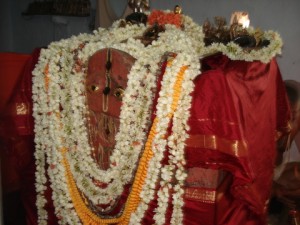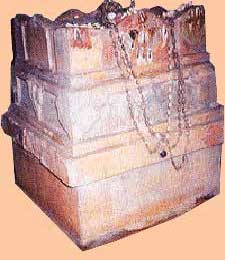Sri Akshobhya Tirtharu
Aradhana Day – Margashira Bahula Panchami
Vrundavana @ Malakheda, Near Kagini River
Ashrama Gurugalu – Sri Madhwacharyaru
Ashrama Shishyaru – Sri Jayatheertharu
yO vidyaaranya vipinam tattvamasyachinath |
shrImadakshObhyatIrthaarya hamsEna tam namaamyaham|
ಯೋ ವಿದ್ಯಾರಣ್ಯ ವಿಪಿನಂ ತತ್ತ್ವಮಸ್ಯಸಿನಾಚಿನತ್ |
ಶ್ರೀಮದಕ್ಷೋಭ್ಯತೀರ್ಥಾರ್ಯ ಹಂಸೇನ ತಂ ನಮಾಮ್ಯಹಮ್|
यो विद्यारण्य विपिनं तत्त्वमस्यसिनाचिनत् ।
श्रीमदक्षोभ्यतीर्थार्य हंसेन तं नमाम्यहम्।
Janma Naama – Sri Govinda Bhatta (Govinda Shastri)
Took Peetadhipathitva from Sri Madhava Tirtharu in 1350AD
He was in the Vedanta Samrajya from 1350-1365AD for 15 years
After giving Sanyasashrama to Sri Govinda Bhatta and renaming him as Sri Akshobhya Teertharu, Shri Madhvacharya gave him the Deity of Aja-Vithala. (Krishna standing with His hands on His hips, accompanied by Shri Devi and Bhudevi, though some say this is Krishna with Rukmini and Satyabhama).
Grantha – Madhwatattvasarasangraha (not available)
Contemporaries – Srimadacharyaru, Sri Padmanabha Tirtharu, Sri Narahari Tirtharu, Sri Madhava Tirtharu, Sri Trivikrama Panditacharyaru, Sri Narayanapanditacharyaru, Sri Jayatirtharu, Sri Vidyaranyaru (Advaitha pandit), Sri Vedanta Deshikacharya (Sri Vaishnava pandit).
Akshobhya Tirtharu – Some Poorvashrama Informations –
He was the son of Sri Keshava Bhatta (He was the controller of a province named Mangalavede). He had two sons, elder is Dhundiraja or Dondo Raghunatha (Father of Jayatheertharu), and the younger is Govinda Bhatta. Govinda Bhattaru learnt his initial education in Gurukula at ‘Degave’ named Village. Govinda Bhattaru even after twenty years of studying in Gurukula never returned home. He was always fond of reading various dharmika granthaas, and was very enthusiastic about tathva jnaana. He had the habit of collecting Sanskrit, Kannada and Marathi lipi granthas and manuscripts. He was wandering from place to place in search of books. He visited Venugrama, Halasi, Balligrama, dwaravathi, Talagunda, Aihole, Pattadakallu, etc. His father Keshava Bhattaru was always objecting for his son’s behaviour. His father was always forcing him to marry, but he was not ready. Then Sri Keshava Bhattaru asked his son as to whether he will take Sanyasashrama?, for which Govinda Bhatta said that he is ready to take provided a yogra guru offers him that Sanyasa. His father told him “We are not from Vaidhika sampradaya family, we have to rule the state, and if situation requires, we may have to fight in the war field”. But Govinda Bhatta told his father he is not interested in any political aspirations.
Once his father made a plan to get son married and invited a bride for his son Govinda Bhatta. Knowing somehow, he left the house and did not return home for months together, as he was not interested in marriage.
Keshava Bhatta breathed his last when Govinda Bhatta was away for a long time, and during his final stages, he called Dhondo Raghunatha (Dundiraja) and told him to look after his younger brother Govinda bhatta. Finally Govinda Bhatta came home and stayed in his brother’s house reluctantly.
His Daily routine –
He used to get up early in the morning daily In the brahmee muhurtha, doing snaana and other ahneeka and other pratharvidhi. He used to study some shastra grantha upto 11 am. Then, he used to do snaana again, madhyahnike, devatacharna, naivedya, and bhojana after giving to athithi-abhyagatharu.
Sri Padmanabha Tirtha’s Darshana –
Once Dhundiraja had gone out for his official work in the Palace. At that time came Sri Padmanabha Tirtharu, who was on his way to Udupi. Dhundiraaja had invited him once to come to his house. On hearing that it is Padmanabhatirtharu, the direct disciple of Srimadacharyaru, he did sastanga namaskara to the sage and asked him to give sanyasa. But Padmanabha Tirtharu told him that he is not his swaroopoddaraka and that the swaroopoddaraka for every one of us is there in Udupi and asked him to meet Srimadacharyaru.
Srimadacharyaru gave Ashrama to Govinda Bhatta – Sri Padmanabha Tirtharu took Govinda Bhatta to Udupi to seek Acharyara blessings for Govinda Bhatta. It was Amavasye – A Suryagrahana Day. Srimadacharyaru went to the sea to have samudra snaana. As it was an Amavasye, the waves were very strong and very high also. Srimadacharyaru called his disciples also to have samudra snaana, but they hesitated to go on seeing the waves. At that time Sri Padmanabha Tirtharu, Sri Narahari Tirtharu and Sri Madhava Tirtharu were all there. No one did go. But Govinda Bhatta went near Srimadacharya without even removing the dress which he was wearing.
The elephant sized waves came and took Govinda Bhatta. Immediately Srimadacharyaru showed his hands in Abhaya Mudra, for which Samudra raja yielded and the entire sea was calm, by that time, Govinda Bhatta, whom the waves had taken was near Srimadacharya’s paada kamala (foot). Acharyaru lifted him, and as soon as the sparsha of Srimadacharyaru was on Govinda Bhatta, he had aparoksha Jnaana. All the other shishyas were surprised on seeing the scene and as the sea was calm, they all came to the sea to have a dip at it., they followed Srimadacharyaru to Kanvateertha. There Srimadacharyaru told him that this was an auspicious day for taking sanyasashrama. He gave the pranavamantropadesha and renamed Govinda Bhatta as Akshobhya Tirtha.
Srimadacharyaru after giving him sanyasashrama, preached him the Vaishnava Tathva. Already Govinda Bhatta was not fascinating towards Advaitha Matha, even though he was born as an advaitee. Now with the anugraha of Srimadacharyaru he learnt Harisarvottama Tattva, Bedha Tattva, Jeevottama Tattva.
Anugraha to Dundiraaja –
After taking sanyasa Akshobhya Tirtharu, once he visited MangalaveDe, where his poorvashrama brother Dhundiraja and his wife were there. Dhundiraja was worried that his family chain is lost with the sanyasa of Govinda Bhatta, and as Dhundiraja had no issues at all. At that time Dhundiraja was 40 years. Then Akshobhya Tirtharu advised Dhundiraja’s wife (his sister-in law of poorvashrama) to worship Ahobala Narasimha, and that he will get three children”.
Akshobhya Tirtharu left Mangalavede . After a long time, Dhundiraja got a male child, but that child died within a month. Then again another child was born, and they decided to name the child as “Gundappa” – Akshobhya Thirtharu named him after Ahobala Narasimha Devaru as “Narasimha”. The same child was none other than Sri Jayatheertharu. By this time Dhundiraja’s age was 55 years. Akshobhya Tirtharu was there for Jaathakarma, Annaprashana, Choula, aksharabhyasa. He was knowing that the child will be a great personality in future. At the age of 8 for Gundappa or Narasimha, Dhondopantha did the Upanayana to his son with the blessings of Akshobhya Tirtharu.
Tattvamasi “ತತ್ತ್ವಮಸಿ” “तत्त्वमसि” vaakyartha with Vidyaranya –
It was an historic event occurred in Mulbagilu, in Kolar District.
It was presided over by so many Dwaitha-advaitha-Vishistadvaita Pandits from various parts of India. The judge was Sri Vedanta Deshikachar, a Srivaishnava pandit. Argument was between Sri Vidyaranya, a great scholar from Advaita parampare and Sri Akshobhya Tirtharu, a Dwaitha scholar.
Akshobya Tirtharu – Srimannarayana is anantha gunaparipoorna, doshatidoora. Srihari is sarvottama, sarvajna, sarvakartha,
Vidyaranya – Srihari is not sarvottama, paramathma is Abhinna from Jeeva. The jnaana that Sri hari is sarvottama is not the sadhana for Moksha. “Aham Brahmasmi” jnaana is the moksha sadhana.
Akshobya Tirtharu – “tattvamasi” – In “sa aatma tattvamasi” “स आत्मा तत्त्वमसि”, “ಸ ಆತ್ಮಾ ತತ್ತ್ವಮಸಿ” we can do padacheda as tattvamasi, and atattvamasi, but atattvamasi holds good and this will be bedha para.
Akshobhya Tirtharu – “Jagat Satya”. This he proved with many pratyaksha, aagama, anumana pramaanaas.
Sri Vidyaranyaru was doing vyaKyana for “Vishwam satyam” a Vedava vaakya – and said Satyam means – “yathaartham” “ಯಥಾರ್ಥಂ” “यथार्थं” , For “ವಿದ್ಯಮಾನಮೇವ” VidyamaanamEva””विद्यमानमेव” – he said “ನತ್ವಾರೋಪಿತಂ ಇತ್ಯರ್ಥ:” “नत्वारोपितं इत्यर्थ:”.
He was arguing that even though ‘Satya’ word has the yataartha meaning, he was telling it is ‘kalpita’.
Finally Sri Akshobhya tirtharu proved that :–
-
Jagat satya in all subjects like veda, brahmasutra, geetha, pratyaksha, anumaana, etc pranaamaas.
-
There is no proof in any of veda, sootra, geetha to suggesting that Jagat is mitya.
-
Brahmanaadhi Varna, Brahmacharyaadi ashrama, Yajna, yagaadi, devate, veda, all are paramarthika satya.
In this way, he condemned the entire arguments by Vidyaranya and proved that “Bedha Tattva” or “Madhwa Tattva” is supreme over all other “tattvas.”
After a detailed discussion and vakyartha, Vidyaranya accepted his defeat.
The entire arguments between Vidyaranya and Akshobhya Tirtharu was sent to Vedanta Deshika charyaru, who after verifying the entire documents, arguments and gave his decision with the shloka as :
asinaa tattvamasinaa parajIvaprabhEdhinaa |
vidyaaraNmaM mahaaraNyaM akShObykamunirachchinat |
ಅಸಿನಾ ತತ್ತ್ವಮಸಿನಾ ಪರಜೀವಪ್ರಭೇಧಿನಾ |
ವಿದ್ಯಾರಣ್ಮಂ ಮಹಾರಣ್ಯಂ ಅಕ್ಷೋಭ್ಯಮುನಿರಚ್ಚಿನತ್ |
असिना तत्त्वमसिना परजीवप्रभेधिना ।
विद्यारण्मं महारण्यं अक्षोभ्यमुनिरच्चिनत् ।
Meaning – Akshobhya Munigalu defeated through Vakyartha named sword Vidyaranya’s jungle forest in the “Tatvamasi” vakyartha, wherein Tatvamasi clearly says that there is a broad difference between Paramathma and Jeeva.
————————————————————
The same shloka has been carved at Vijayastambha in Mulbagilu. But later some miscreants tried to destroy the facts, they have damaged the writings in the pillar, which can be observed from the article as mentioned below.
(Akshobhya Thirthara Vijaya Sthamba)
-
There is an article in Mysore Archeological Survey Department published in 1886 report as follows –
At Mulbagil in inscription in Grantha characters on a boulder was brought to notice which appears to record the fact of a refutation of Vidyaranya by Akshobhya Tirtha, in some public disputation. But the inscription has been lately purposely destroyed, so that a few letters remain visible. The above account of its contents is given by pesons who saw it before it was damaged and who had made a copy of it.
——————————————————————————-
Sri Doddayyacharya, a Vishistadvaita vidwan has written a Grantha titled “Vedanta Deshika Vaibhava prakashiga”, wherein he has said like this –
ಕದಾಚಿದಕ್ಷೋಭ್ಯಮುನೀಶ್ವರಸ್ಯ |
ರಣಸ್ಯ ಜಾತಂ ಬಹುಳಂ ವಿವಾದಂ |
ವಿಲಿಖ್ಯಾಕ್ಷೋಭ್ಯವಿಬುಧಾಯ ಯಸ್ಮೈ |
ಸಂಪ್ರೇಷಯಾಮಾಸ ತಮಾಶ್ರಯೇಹಂ |
ತತ್ತ್ವಮಸಿನಾಸಿನಾ ತಂ ವಿದ್ಯಾರಣ್ಯಂ ಮುನಿಸ್ತದಾಕ್ಷೋಭ್ಯ: |
ಅಚ್ಚಿನದಿತ್ಯವದದ್ಯ: ತಂ ಸೇವೇ ತತ್ತ್ವನಿರ್ಣಯೇ ಚತುರಂ |
कदाचिदक्षोभ्यमुनीश्वरस्य ।
रणस्य जातं बहुळं विवादं ।
विलिख्याक्षोभ्यविबुधाय यस्मै ।
संप्रेषयामास तमाश्रयेहं ।
तत्त्वमसिनासिना तं विद्यारण्यं मुनिस्तदाक्षोभ्य: ।
अच्चिनदित्यवदद्य: तं सेवे तत्त्वनिर्णये चतुरं ।
——————————————————————————————
“ಕಿಂ ಪಶು: ಪೂರ್ವಧೇ:” – “किं पशु: पूर्वधे:” A great shishya is found
Akshobhya Tirtharu was searching for a shishya who can take over the Madhwa Peeta. Once he went to Pandarapura and ask for a uttaradhikari. One day in his dream, he asked Panduranga Vittala to show his uttaradhikari, there Panduranga showed him to ask Srimadacharyaru. Then he went to Srimadacharyaru, who advised him to sit for Japa near the river, one handsome horse rider will come and he will drink water in the river by sitting on the horse itself and that he will be his uttaradhikari. It was in his dream.
Next day, he was sitting for Japa near the river, there he saw an young boy came alongwith his friends. He was so thirsty that he entered the river riding on the horse itself, and bending drunk the water sitting on the horse like an animal. Akshobhya Tirtharu on seeing him told “”किं पशु: पूर्वधे:” – “Were you an animal in your previous birth”. All of a sudden the horse rider turned and saw the yathigalu who was sitting near the river. He remembered everything about his poorvashrama wherein he had listened to Srimadacharya’s paata pravachana when he was a bullock. He went straight to Akshobhya Tirtharu and asked him to take him as a shishya. He also realized that the yathigalu Sri Akshobhya Tirtharu was none other than his own uncle, who had assisted him in his initial paata, sandhyavandana. Akshobhya Tirtharu was also happy that it was his own nephew (in his poorvashrama) and was happy and gave him ashrama. Jayatirtharu went to write several teekaas for Srimadacharya’s work.
(Source Sri Korate Srinivasarao’s book on Sri Jayatirtharu published in 2003)

